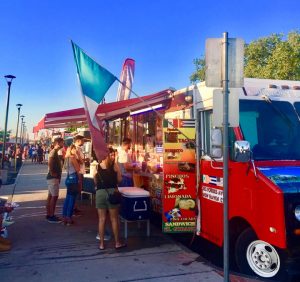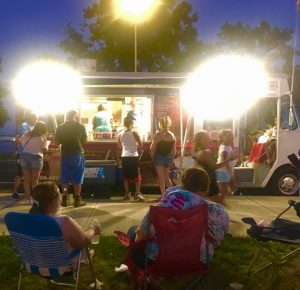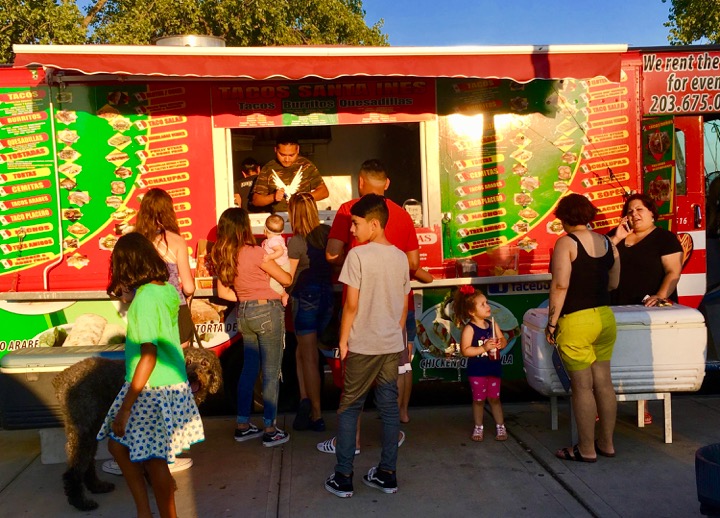It’s a quiet, lazy summer afternoon in New Haven on the stretch of harbor along I-95 on Long Wharf Drive. The temperature is in the mid-80s but the gentle breeze off the still water makes it a perfect day for lounging along the banks; biking, jogging or Fitbitting on the winding lane; or even indulging in a bit of paradise.
Food Truck Paradise, that is – the name city officials designated for the area, they say, based on a phrase that popped up during a Google Maps search and has since become branded for this homegrown collection of two dozen-plus kitchenettes-on-wheels that offer alternative food, flavors, and dining.
From the highway above, it might look like a string of Matchbox vehicles but it’s a parallel world unto itself. Look at the cars and trucks lined up in the parking spaces with the different colored license plates, their drivers succumbing to the lure of the lingering lunch with a view. Others come from the city center or just beyond, in search of take-out that would make them office heroes. For some, it’s an affordable, al fresco date. For others, it’s a family outing and a picnic near the peaceful shallow waters with the occasional seagull squawking, punctuating the low drone from the highway traffic in the distance.
Tom Curley has driven along this same stretch of highway countless times and wondered about the increasing number of food trucks lined up over the last few years (they currently number around 30, depending on the day, weather and season).
On this day, when he and his 18-year-old daughter Samantha went shopping at IKEA, he decided to finally check out this unusual collection of movable feasts and see what the fuss is all about.
They drove out of the store’s parking lot, went under the highway and took a right onto the frontage road, where they gazed upon truck after truck offering primarily Latin street food, but also ice cream, hot dogs, and Asian food, too.
“I’ve seen food trucks in Manhattan and even a few gathered together under The High Line in Chelsea but nothing quite like this,” he says, as they finished their taco plates, seated on the thick wooded fence that borders a grassy knoll overlooking the shore.
And how does he choose among the venders?
“I look for one where the locals are lining up,” says the special education teacher from Brewster, N.Y. “It was between this one and another truck further down the line. I’d definitely come back.”
For Samantha and others in her generation, it’s less a food novelty and more a natural go-to.
“I just finished my first year of college and whenever there’s food trucks around, that’s just where me and my friends go. It’s easy to grab and go or just to hang out.” She says they prefer the trucks to the fast-food chains like McDonald’s. They’re run by people who own their own businesses and who make good, authentic, affordable food without attitude.
“It’s fresh food. It’s fast. It’s good,” says Felix Sanchez who runs the Sabor Mexico truck, which like many of the venders offers condiments galore (you’re welcome) to his menu of tacos, tostadas, enchiladas, burritos, quesadillas, nachos, tamales (usually on weekends) – and much more.
More choices abound along the long stroll, where colorful menus boast about their tortas, chalupas, cemitas, sopas, huevos rancheros, and roasted corn-on-a-stick smothered in a mixture of mayo, cheese, and spices. Vegetarian selections, too, are abundant. Drinks? Slushy drinks, limonada or horchata, a plant-based milky beverage.

Lonely Beginnings
But Paradise took time.
And in the beginning, there was Bob. Just Bob.
“I was the first.”
That’s Bob Sweeney, 78, who has sold hot dogs in his “Sweeney’s” truck on this stretch for 60 years. “I was here even before there was a highway. They were building it when I first arrived. Before that, this stretch was just a dirt road. At that time, it was just me and the seagulls.”
He says his business grew slowly, attracting truckers off the highway who needed a quick bite. “It’s been good to me,” he says, adding that it allowed him to be his own boss while being able to support his family and send his children to college.
This historic harbor didn’t look so nice in those early days, he says, and the waterfront was a bit of an outlander orphan in the seemingly Yale- and downtown-centric city, even though it acted as a de facto gateway into the city. Now it offers a fine howdy-do to those approaching New Haven, the trucks’ flags waving below in the sea breeze and, if the wind is just right, a faint aroma of sizzling fajitas adds to the welcome.
“The water’s very clean now but when I first got here, you couldn’t even stand on the bank because it stunk so bad,” says Sweeney. “Then the city or state or whatever started spending more money to clean up the beach and more people started coming down here. Not in big droves. But gradually. One thing I’ll say, they did a hell of a job cleaning that water. Now it’s safe. And it doesn’t get deep until you get way out, so people come with their kids. What they’re drawn to is the location.”
That’s when a few other food trucks arrived, which Sweeney saw not as competition so much as a way to attract more people there. Then another truck arrived. Then more.

“Then the city got involved and, well, nothing is for free,” he says. He praised the water cleanup, the new sidewalks, and lighting but he isn’t a fan of the new licensing fees and the regulations that came with them.
When it came time to formalize the area as a designated food truck center with allocated spots, Sweeney, who operates the truck with his older brother Ed, was the first to choose where he wanted to be among the now-designated locations.
And his selection?
“The middle is the best spot,” he says. “Always go for the center.”
Sweeney says he has no plans to change the $2 prices of his wieners and buck sodas nor end his status as king of the road. “We’re rounding third base and we’re heading for home,” he jokes, referring to their ages. “But we’re not going anywhere.”
More Tables, Please
And neither is anyone else, now that this piece of paradise has been spiffed up with upgrades, including 1,000 feet of new sidewalks, 12-foot tall lights, pedestrian crossings, bike lanes, parking areas, solar-powered “Bigbelly” trash containers, and 17 new electrical plug-in stations that eliminated the noise and smell of fossil fuel generators. It’s part of more than $3 million in improvements for the overall area, which also includes landscaping and construction of a new boathouse and visitors’ center.
Bob Pace, 52, a construction worker who lives in Hamden, regularly comes here but he has a recommendation to the city. “More picnic tables,” he says. “If there were, maybe I’d hang out here more, but generally I just get the food and leave.” He then pointed to the dumpsters filled to the brim: “And oh yeah, make it cleaner.”
Yandry Jaramillo, 35, of Elizabeth, N.J. is a freelance trucker who has turned off the highway for the past eight years, whenever he drives through about twice a week. “I haven’t seen anything quite like this,” he says.
Norma Feliciano sits on a lawn chair in front of Winn Pinchos, her food truck. She is the new kid on the strip, having previously been around town in other locations. Her menu offers Puerto Rican classics: pinchos (kabobs), empanadillas (turnovers), mofongos (mashed green plantains with garlic), bacalaitos (codfish fritters) and carrucho (conch salad).
“You know what it is,” she says about the area. “Here you get to try so many different foods. Like I’ve never had the mangos with –” She turns to her friend, “What is it that you put on it?”
“Hot sauce.”
“Hot sauce. Right. Delicious.”

Not every one of the slots are filled every day but most were back in force – and then some – for the fifth annual New Haven Food Truck Festival held in June, where there were close to 50 trucks that attracted thousands to this epic smorgasbord, including seafood items, burgers, and even one truck that offered deep-fried Oreos.
But beyond the festival, weekends are when the trucks are busiest. Weekdays are slower, with a little burst of business at lunchtime and again at dusk, when seaside sunset lovers get peckish.
Late-night business comes and goes as the neon and florescent lights come on, illuminating the line of trucks, now dwindled to about a dozen or so. Time slows as the night winds down. With the blue lights of the sculptural Q-Bridge in the distance, the half-moon reflected on the harbor and steady blinks coming from Lighthouse Point, the last customers finish their plates. With the final few trucks shutting down and rolling away, it’s time to call it a day – and night – in Paradise. Until tomorrow.






More Stories
Happy Senior Hour for the Holidays
At Home With Kerri-Lee
A New, Free Peabody Museum Prepares for Opening